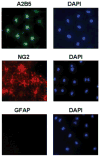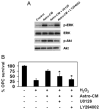Astrocytes protect oligodendrocyte precursor cells via MEK/ERK and PI3K/Akt signaling
- PMID: 19830833
- PMCID: PMC3705578
- DOI: 10.1002/jnr.22256
Astrocytes protect oligodendrocyte precursor cells via MEK/ERK and PI3K/Akt signaling
Abstract
Accumulating evidence suggest that trophic coupling among different cell types in the brain is required to maintain normal CNS function. Here we show that astrocytes secrete soluble factors that can be oligodendrocyte-supportive. Oligodendrocyte precursor cells (OPCs) and astrocytes were prepared from neonatal rat brain and cultured separately. We conducted cell culture medium-transfer experiments to examine whether astrocytes secrete OPC-protective factors. Conditioned media from astrocytes protected OPCs against H(2)O(2)-induced oxidative stress, starvation, and oxygen-glucose deprivation. This protective effect may be mediated in part via ERK and Akt signaling pathways. Astrocyte-conditioned media upregulated the phosphorylation levels of ERK and Akt in OPC cultures. Blockade of ERK or Akt signaling with U0126 or LY294002 cancelled the OPC-protective effects of astrocyte-conditioned media. Taken together, these data suggest that astrocytes are an important source for oligodendrocyte-supportive factors. Coupling between these two major glial components in brain may be vital for sustaining white matter homeostasis.
Figures





References
-
- Abbott NJ, Ronnback L, Hansson E. Astrocyte-endothelial interactions at the blood-brain barrier. Nat Rev Neurosci. 2006;7:41–53. - PubMed
-
- Arai K, Lee SR, Lo EH. Essential role for ERK mitogen-activated protein kinase in matrix metalloproteinase-9 regulation in rat cortical astrocytes. Glia. 2003;43:254–264. - PubMed
-
- Butt AM, Ibrahim M, Ruge FM, Berry M. Biochemical subtypes of oligodendrocyte in the anterior medullary velum of the rat as revealed by the monoclonal antibody Rip. Glia. 1995;14:185–197. - PubMed
-
- Canoll PD, Musacchio JM, Hardy R, Reynolds R, Marchionni MA, Salzer JL. GGF/neuregulin is a neuronal signal that promotes the proliferation and survival and inhibits the differentiation of oligoden-drocyte progenitors. Neuron. 1996;17:229–243. - PubMed
Publication types
MeSH terms
Substances
Grants and funding
LinkOut - more resources
Full Text Sources
Other Literature Sources
Medical
Miscellaneous

